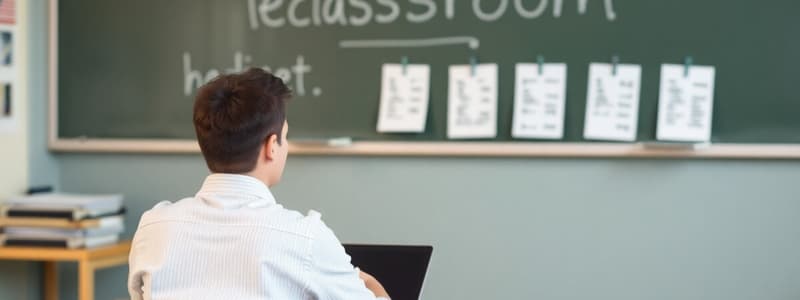Podcast
Questions and Answers
What is the primary goal of implementing classroom management strategies?
What is the primary goal of implementing classroom management strategies?
- To reduce teacher workload and stress
- To minimize the need for disciplinary actions
- To create a silent and highly structured classroom environment
- To enhance pro-social behavior and increase student academic engagement (correct)
Effective classroom management principles apply differently across various subject areas and grade levels.
Effective classroom management principles apply differently across various subject areas and grade levels.
False (B)
What are the two issues teachers typically need help with regarding classroom management?
What are the two issues teachers typically need help with regarding classroom management?
Preventing discipline problems and dealing with current discipline problems.
A well-managed classroom with routines and rituals helps students feel more ______.
A well-managed classroom with routines and rituals helps students feel more ______.
Match the following classroom management approaches with their descriptions:
Match the following classroom management approaches with their descriptions:
What is a key component of Tier 1 (Universal Level) within a Positive Behavior Support (PBS) system?
What is a key component of Tier 1 (Universal Level) within a Positive Behavior Support (PBS) system?
Positive behavior support systems are more frequently implemented in high schools than in elementary schools.
Positive behavior support systems are more frequently implemented in high schools than in elementary schools.
What are some strategies high schools use to resolve behavioral issues, other than prevention-based classroom management systems?
What are some strategies high schools use to resolve behavioral issues, other than prevention-based classroom management systems?
When implementing classroom management strategies in high schools, it's crucial to involve students in the development and implementation of ______.
When implementing classroom management strategies in high schools, it's crucial to involve students in the development and implementation of ______.
Which of the following is a recommended strategy for teachers?
Which of the following is a recommended strategy for teachers?
Flashcards
Classroom Management
Classroom Management
The process by which teachers and schools create and maintain appropriate student behavior in classroom settings.
Classroom Management Methods
Classroom Management Methods
Techniques educators use to prevent misbehavior and maintain control in the classroom.
Well-Managed Classroom
Well-Managed Classroom
Classroom environments with routines and rituals to help students feel secure and maximize learning time.
Effective Classroom Management
Effective Classroom Management
Signup and view all the flashcards
Positive Behavior Support (PBS)
Positive Behavior Support (PBS)
Signup and view all the flashcards
Social and Emotional Learning (SEL)
Social and Emotional Learning (SEL)
Signup and view all the flashcards
High School Classroom Adjustments
High School Classroom Adjustments
Signup and view all the flashcards
Effective Classroom Strategies
Effective Classroom Strategies
Signup and view all the flashcards
Study Notes
Classroom Management Definition
- Classroom management is the process of creating and maintaining appropriate student behavior in classroom settings.
- Implementing classroom management strategies aims to enhance pro-social behavior and increase student academic engagement.
- Effective classroom management principles apply across various subject areas and grade levels.
- Educators use classroom management to prevent misbehavior and maintain control in the classroom.
- Lack of effective classroom management can reduce learning and cause unhappiness and stress for teachers, leading to some leaving the profession.
Classroom Management Importance
- Well-organized classrooms with routines and rituals help students feel more secure, as children need structure.
- Routines and rituals in a well-managed classroom increase time for learning, with teachers spending more time teaching and less time getting class started.
- An organized classroom enhances the learning environment, making students more engaged and less distracted.
- Clear rules and consequences reduce the need for teachers to nag and discipline, preventing fatigue and teacher burnout.
- Clear rules and consequences allow teachers to have better rapport and enables both students and teachers to enjoy the educational process more.
- Discipline issues are spotted and addressed quickly in a well-managed classroom.
- Students are more likely to feel treated fairly when they understand the policies from the beginning.
- Classroom management provides students parameters that help them feel control over their environment.
Effective Classroom Management
- Establishes and sustains an orderly environment in the classroom.
- Increases meaningful academic learning and facilitates social and emotional growth.
- Decreases negative behaviors and increases time spent academically engaged.
- Classroom management systems increase student success by creating an orderly learning environment, enhancing academic skills/competencies, and supporting social/emotional development.
- Effective systems adhere to emphasizing student expectations, promoting active learning/involvement, and identifying important student behaviors for success.
- Teachers concerned with classroom management typically need help with preventing or dealing with discipline problems.
- Positive behavior support (PBS) and social and emotional learning (SEL) are systems established to address these concerns.
- Positive Behavior Support (PBS) is a multilevel intervention model with a school-wide support structure for teachers adopting evidence-based programs, and small group/individualized programs for students needing more support.
- Teachers and staff create a positive school culture at the school-wide level by clearly defining expectations taught to all students and adults.
Tier 1: Universal Level (PBS)
- The school establishes behavior expectations.
- Students, staff, and families understand these expectations; schools operationalize positive behaviors and teach them.
- Teachers have pro-social contacts with students and model expected behaviors.
- Teachers receive formal training in behavior management.
- The school establishes a school-wide leadership team to support PBS activities.
- The school implements a system for recording student behavior to facilitate decision-making on potential intervention/responses.
Tier 2: Secondary Level of Intervention (PBS)
- Evidence-based programs like First Steps to Success can be implemented with groups of students needing this level of support.
Tier 3: Tertiary Level (PBS)
- Individualized evidence-based programs are implemented for students not responding to the second tier, based on behavior data and analysis.
- When needed, teachers consult with colleagues (school psychologists, special education teachers) with expertise in this area because most classroom teachers have not been trained in functional assessment or analysis of behavior.
Social and Emotional Learning (SEL)
- Social and emotional learning (SEL) is affiliated with the Collaborative for Academic, Social, and Emotional Learning (CASEL).
- SEL programs provide instruction at the universal level, teaching social and emotional competencies to enhance success in school/life.
- According to CASEL, effective SEL instruction includes opportunities to practice skills, coordination with school/community environments, consistent programming throughout grade levels, and continuous monitoring.
Classroom Management in High Schools
- Positive behavior support systems are producing strong results for increased pro-social behaviors and decreased negative results in elementary schools, but these systems are less often implemented in high schools.
- High schools sometimes try to resolve behavioral issues by repeating consequences, increasing the averseness of consequences, and establishing bottom line or zero tolerance level policies.
- Other methods include excluding students from attending school through suspensions/expulsions or offering alternative ways of completing the high school experience elsewhere (alternative school, community college).
- Consequences can lead to overly controlling environments, trigger antisocial behavior, shift accountability away from the school, devalue student-teacher relationships, and weaken the link between academic/social behavior.
- Prevention-based classroom management systems in high schools can create a positive school climate, enhance student commitment, teach/reward social skills, and disrupt/monitor antisocial behaviors/interactions.
Effective High School Classroom Management Adjustments
- Adaptations to classroom management strategies are needed due to developmental differences between elementary and high school students.
- Allow students to be involved in goal development/implementation.
- Actively engage students in classroom management strategies by giving them collaborative responsibility for creating/implementing expectations.
- Explicitly teach behavior expectations, similarly to how you would in elementary school.
- Recognize that not all high school students are motivated by academic or social success, so have students individually assist in identifying what they would find reinforcing.
Effective Classroom Management Strategies (Recommendations for Teachers)
- Successful classroom management covers everything from preparing for the school year, dealing with bullying, and forming relationships with administrators.
- Establish a positive relationship with the class.
- Praise can be a powerful tool.
- Welcome feedback from students.
- Create a safe learning environment.
- Use variety to engage students.
- Anticipate problems and be creative.
- Vary your tone.
- Ramp up your enthusiasm.
- Find things to appreciate.
- Establish the expectation that everyone must participate in class every day.
- Assessments should look forward, not back.
- Avoid vague rules.
- Don't patronize or pander.
- Address student behaviors that violate rules.
- Avoid overly harsh/embarrassing punishments.
- Do not try to solve problems alone if you have serious concerns about a student; refer to school psychologist/special education professionals.
Avoiding Disciplinary Problems
- Prepare lessons thoroughly.
- Show interest.
- Study those who have difficulty understanding.
- Demonstrate confidence and act as someone who expects students to meet your requests.
- Speak convincingly/ clearly, avoiding monotony and using language that students understand.
- Avoid noticeable personal mannerisms that can destruct attention.
- Ensure everyone is paying attention before you before starting the lesson.
- Stop teaching when the class becomes too talkative or inattentive and re-establish expectations before resuming.
- Keep pupils busy all the time.
- Stop misbehavior and ignore petty matters.
- Avoid useless threats.
- Distract pupils whose attention is wavering by giving them a task.
Studying That Suits You
Use AI to generate personalized quizzes and flashcards to suit your learning preferences.




